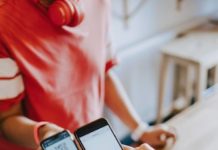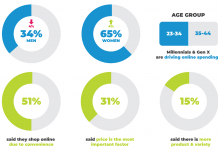Throughout the history of computing, the fundamental goal has been data processing. This involved carefully collecting, curating and storing data to be processed by machines. Megan Walker, Senior Media Strategist at The MediaShop, looks at the Internet of Things (IoT) in the retail and media space.
In essence, IoT is the interconnection, via the internet, of computing devices embedded in everyday objects, enabling them to send and receive data. So, it is the concept of connecting any device (that has an on/off switch) to the internet, and in some instances to other connected devices. Examples include an extraordinary number of objects of all shapes and sizes from smart microwaves, which automatically cook your food for the right length of time, to self-driving cars, whose complex sensors detect objects in their path, to wearable fitness devices that measure your heart rate and the number of steps you’ve taken that day, and that use that information to suggest exercise plans tailored to you.
In investigating IoT, I found an article listing a number of historical and interesting facts and for extended context, at least five of these were well worth sharing.
Did you know?
· Automated teller machines (ATMs) represented the first generation of IoT products when they started coming online in 1974.
· By 2008, there were already more internet-connected devices than there were human beings on the planet.
· General Electric has used IoT for years to improve its jet engine technology. Complex sensors in each airplane can generate up to 14 gigabytes of data per flight. Engineers use this data to make improvements to the plane’s engines and other systems.
· One of the first internet-connected appliances was a Coke machine at Carnegie Mellon University in the U.S. Sensors allowed students to see if the machine was stocked and whether drinks were cold.
· Wearable technologies (Fitbit etc.) which comprise a large portion of IoT devices saw a worldwide growth of 31% in units shipped between 2016 and 2020 (+/- 90 million units shipped in 2020).
IoT is changing and improving many fields; amongst them production, distribution and courier services, retail, commerce and health. These are some of the fields being affected by IoT at an ever-increasing speed. But since I work on the Shoprite account, it is only natural that I specifically look deeper into examples of how IoT has and will continue to shape and impact the retail sector.
· Predictive maintenance of equipment for grocery stores and malls. IoT devices make predicting equipment failure or detecting equipment issues before they happen possible, for example, a refrigeration unit can be fitted with a sensor to detect imminent failure.
· Transportation – GPS for tracking and route optimisation. GPS used to track the vehicles carrying merchandise make it easy for retailers to track dispatch and arrival of inventory.
· In-store and warehouse inventory. With IoT sensors it is possible to manage in-store inventory. Store managers and distribution centres (DC’s) can monitor real-time inventory visibility, thus avoiding stock shortages.
· Smart malls and stores and mapping consumers’ journey. With the help of Wi-Fi and IoT sensors, geo-fencing and beacons, stores and malls can monitor the footfall of consumers. Retailers can now access which malls, which stores, or even which aisles consumers spend more time in.
· Forecasting future trends, demand and supply. Loyalty cards such as the Shoprite and Checkers Xtra Savings cards, and the data that is collected via each transaction in store (or online) allows them insights into the retail habits of their consumers.
· Controlling pilferage or theft. IoT devices help prevent retail shrinkage. When products are fitted with Radio Frequency Identification (RFID) tags, if an attempt to steal a product is made, the tags alert the retailer’s staff.
· Energy management. Malls/retail stores consume huge amounts of energy. IoT enabled smart sensors can be used to monitor energy usage, gas leakage, electricity breakdowns etc. and alert someone to look into problems like leakages or overheating and get them resolved.
All of the above are examples of IoT, which help save the retail industry downtime, manage losses and essentially try to control costs, all while servicing their customers in the best way possible. And as Shoprite like to say, any savings they make can be passed on to their consumers. Closer to home, as media and advertising people, IoT is already prevalent and shaping the way consumer data is both available and able to be used.
Web advertising platforms like Google and Facebook have already figured out how to personalise our internet usage habits, but the IoT lowers the barrier to entry by increasing the available sources of personal information. Connected devices quite literally connect all of our online profiles, allowing advertisers to build individual consumer profiles of each person easily. This equals more personalised and more effective marketing campaigns.
Connected devices will have the ability to compile much more data about our entire population than we can imagine. As a result, there will be a growing need to find better uses for this influx of data – big data will be more important than ever. We can expect to see more big data companies specialising in explaining and providing insights about the IoT to their consumers, healthcare providers, manufacturers and even insurance companies. The swift explosion of the IoT has already created a bigger market for social media platforms, websites, and apps that help people manage their IoT devices, and expect more of the same in the future.
While much of the attention in the IoT world is around the explosion of software in everyday devices, another technology revolution is happening that might be even more far reaching in impact. The cloud itself is changing from a place where data is collected and stored to a place where it is being interpreted and understood through the power of machine learning.
Machine learning for IoT is already being used to project trends, detect irregularities and much more. The power of machine learning is really at the point of just having the surface scratched – there are many who believe that as machine learning technology improves in the future, there will be tasks that would be increasingly done completely by robots with AI. But that’s a subject for another blog.
THE MEDIASHOP
+27 11 258 4000
www.mediashop.co.za










